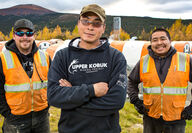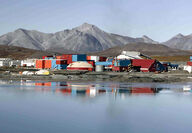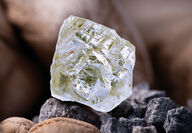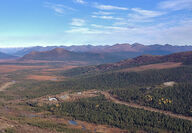Sorted by date Results 176 - 200 of 239

The value of non-fuel metals produced in Alaska and the United States during 2018 were similar to 2017, according to Mineral Commodity Summaries 2019, an annual report published by the U.S. Geological Survey. Alaska mines produced roughly $3.44 billion worth of non-fuel minerals last year, down nearly 3 percent from the US$3.53 million in 2017. This slight drop is largely due to lower output from the two largest mines in the state – Fort Knox and Pogo. The roughly 1.4 b...

The Red Dog Mine has been a gamechanger for the more than 14,000 Iñupiat shareholders of NANA Corp., the Alaska Native Claims Settlement Act (ANCSA) regional corporation that owns the world-class Red Dog deposits in Northwest Alaska that are the source of around 5 percent of the world's new zinc supply each year. The revenues from shipping out more than 1 billion pounds of zinc annually, along with healthy portions of lead, silver and minor amounts of germanium, has served...

Alaska boasts what many consider the most successful Aboriginal land claims settlement on Earth – a solution that has not only turned out to be a cultural success, but a brilliant business move for the more than 140,000 Alaska Natives and an economic boon for the state that covers the resource-rich lands these industrious and innovative peoples have called home for millennia. Signed into law by U.S. President Richard Nixon in 1971, the Alaska Native Claims Settlement Act, comm...

In addition to being a past producer and a future source of most of the 35 minerals and metals considered critical to the United States, Alaska currently contributes a globally significant amount of one of these vital metals – germanium. While not a widely known metal, germanium has optical qualities that make it an important ingredient in fiber-optics, infrared optics, electronics and solar energy systems. "The extensive use of germanium for military and commercial a...

With nearly indistinguishable physical and chemical properties, niobium and tantalum are almost always found together in nature. Both are also critical to the defense, energy and high-tech sectors in the United States, but neither are mined domestically. For these reasons, the United States Geological Survey considers these transition metals "indispensable twins" that are critical to America's economic and strategic wellbeing. "Niobium and tantalum are transition metals that...

With a melting point of 5,756 degrees Fahrenheit and a heat-stable crystalline structure, rhenium is extremely resistant to both heat and wear. This durability makes it a vital element in superalloys used in jet and industrial gas turbine engines. "The high-temperature properties of rhenium allow turbine engines to be designed with finer tolerances and operate at temperatures higher than those of engines constructed with other materials," the United States Geological Survey...

Constantine Metal Resources Ltd. Aug. 13 reported that results from metallurgical testing demonstrate a premium-quality barite concentrate can be produced as a co-product to the copper, zinc, gold and silver found in the volcanogenic massive sulfide deposit at the Palmer project in Southeast Alaska. According to a resource calculated in 2015, the South Wall-RW deposit at Palmer hosts 8.1 million metric tons of inferred resource averaging 5.25 percent (940.4 million pounds)...

Northwest Territories may fall behind Canada's two other territories in mining activity in the near-future, but projects underway in the northern jurisdiction hold substantial promise for mid- to long-term gains, especially if many current roadblocks come down. "Optimism is warranted for the territory's mining sector and the broader economy it drives," said Wally Schumann, minister of industry, tourism and investment for the Government of Northwest Territories. But...

Extremely hard and with the highest melting point of all the elements on the periodic table, tungsten is a vital ingredient to a wide-range of industrial and military applications, yet none of this durable metal is currently mined in the United States. According to the United States Geological Survey, more than half of the tungsten consumed in the U.S. last year was used to make the cemented tungsten-carbide, a compound typically made with equal parts tungsten and carbon....

A vital ingredient in stainless steel and superalloys, chromium is considered by the United States Geological Survey as "one of the Nation's most important strategic and critical materials." "Because there is no viable substitute for chromium in the production of stainless steel and because the United States has small chromium resources, there has been concern about domestic supply during every national military emergency since World War I," the USGS explains. Rich chromite...

Trilogy Metals Inc. May 28 said it is gearing up for another busy field season at its Upper Kobuk Mineral Projects in the Ambler Mining District of Northwest Alaska. The US$16.7 million of work programs budgeted for UKMP in 2018 will focus on gathering the data to advance the Arctic project towards feasibility and permitting, as well as drilling to expand and upgrade the large copper resource at Bornite. As crews continue to advance these large and high-grade metals deposits,...

In an initial move to implement President Donald Trump's strategy to break the United States' growing reliance on foreign countries for minerals and metals vital to its security and economy, the U.S. Department of Interior published a final list of 35 critical minerals on May 18. An executive order signed by President Trump in December instructed Secretary of Interior Ryan Zinke, in consultation with Secretary of Defense James Mattis, to identify and publish a list of...

Seven days of near-continuous rain did nothing to dampen the mood at the recently concluded Cordilleran Roundup Convention in Vancouver. The event was buoyed by a realistic optimism we have not seen in over five years. This change from half-empty to half-full glasses is due to a number of things including strong commodities prices, increasing global demand for metals and current or looming supply shortfalls in many of the metals produced by this industry. The event was...

With 13 holes drilled in 2017, CopperBank Resources Corp. has added more than 160 million pounds of copper to its Pyramid project on the Alaska Peninsula. "For a small investment in 2017, our team was able to significantly increase the scale, confidence and quality of the project," CopperBank Executive Chairman Gianni Kovacevic said upon the Feb. 2 release of an updated resource for Pyramid. Kovacevic has been a strong advocate for copper as a "green metal" that will see...

Ucore Rare Metals Inc. Dec. 22 said President Donald Trump's executive order to ensure reliable supplies of critical minerals is a fundamental policy shift that is important to the company and its Bokan Mountain rare earth elements project in Southeast Alaska. The executive order signed by Trump on Dec. 20 instructs federal agencies to identify and publish a list of critical minerals, and develop a strategy to reduce the United States' reliance on other countries to supply...

The Trump Administration's focus on securing domestic sources of critical minerals could help re-invigorate mineral exploration and mine development in Alaska. At least 15 of the 23 critical minerals identified by the U.S. Geological Survey – antimony, barite, beryllium, cobalt, fluorspar, gallium, germanium, graphite, indium, platinum group elements, rare earth elements, rhenium, tantalum, tellurium, tin and vanadium – are found across the Far North state. Working alo...

Geologists familiar with Alaska already know the Far North State is a great place to explore for critical minerals and metals such as graphite, rare earths, platinum metals, cobalt and tin. A new report published by the U.S. Geological Survey, however, indicates that Alaska may be richer in these and other minerals and metals vital to the economy and security of the United States than previously realized. Working alongside the Alaska Division of Geological & Geophysical...

U.S. President Donald Trump sparked a renewed interest in critical minerals and metals when he issued an executive order calling on federal agencies to devise a strategy to ensure the United States has reliable supplies of these commodities vital to America's economic and strategic security. "It shall be the policy of the federal government to reduce the nation's vulnerability to disruptions in the supply of critical minerals, which constitutes a strategic vulnerability for...

With a melting point of 5,756 degrees Fahrenheit and a heat-stable crystalline structure, rhenium is extremely resistant to both heat and wear. This durability makes it a vital element in superalloys used in jet and industrial gas turbine engines. "The high-temperature properties of rhenium allow turbine engines to be designed with finer tolerances and operate at temperatures higher than those of engines constructed with other materials," the United States Geological Survey...

Exploration companies familiar with Alaska already know the Far North State is great place to look for critical minerals such as rare earth elements, platinum group metals, cobalt and tin. A new report published by the U.S. Geological Survey, however, indicates that Alaska may be richer in these and other minerals vital to the United States than previously realized. Working alongside the Alaska Division of Geological & Geophysical Surveys, USGS developed a new geospatial tool...

The path to discovering the viability of developing a mine at Arctic and the road needed to deliver the copper, zinc, lead, gold and silver from this exceptionally high-grade Northwest Alaska deposit to world markets are both making headway in 2017. Arctic is the most advanced of the high-grade deposits that make up the Upper Kobuk Mineral Projects, an extensive land package that unites Trilogy Metals Inc.-controlled mining claims that blanket a 70-mile- (110 kilometer) long...

American miners hailed President Donald Trump’s plans to slash the red tape holding back infrastructure projects in the United States as positive step in repairing the United States’ deteriorating roads, rails, ports, and airports – a move that could also bolster the industrial sector that would supply the sand, gravel, concrete, zinc, copper and other mined materials needed for the President’s proposed US$1 trillion infrastructure enterprise. “President Trump’s welcome ini...

A former high ranking United States Army executive charged with acquiring and developing world-class equipment for U.S. soldiers under the Obama and Bush administrations warns that the lack of a domestic source for rare earth elements, or REEs, will be the Achilles heel of American military superiority. "Every one of the current and next round of super and unimaginable US weapons relies on REEs, an exotic assortment of 17 metals and elements, that are neither mined nor...

Alaska is rich in mineral potential but poor in the critical infrastructure needed to fully realize this potential, that was the message Alaska Division of Geological and Geological Surveys Director Steve Masterman delivered to lawmakers on Capitol Hill. During a March 30 hearing, Masterman informed member of the U.S. Senate Committee on Energy and Natural Resources that Alaska could be the answer to the United States growing dependence on foreign suppliers for minerals....
KSM, an enormous gold-copper project in northwestern British Columbia, has received a federal license for water management facilities located on Mitchell and Sulphurets creeks, tributaries of the trans-boundary Unuk River system that flows through Southeast Alaska. "This important permit highlights the government of Canada's continued support for the environmental standards incorporated into our design of the KSM project," said Rudi Fronk, chairman and CEO, Seabridge Gold, the company that is advancing KSM. The issuance of...